Why your product's voice matters
A competitor analysis workshop on copy, tone, and voice
UX writing is still a new discipline for many tech organizations. Copy is seen as an easy and quick fix, where anyone with basic writing skills can do it.
What businesses fail to realize is that platforms communicate with users using copy. It's not just words on a screen—it's the voice of your product.
An opportunity to educate
I was Just Eat Takeaway's first UX writer and spent my first six months evangelizing my role across the company (a familiar theme for us writers). An opportunity came about where I was tasked to analyze the copy of significant food delivery platforms. Rather than dive into this myself, I decided to get my teammates involved as well.
Being the only writer explaining your existence to others is work in itself. I wanted the stakeholders (designers, project managers, researchers, etc.) to witness how much copy impacts the product. If I got them on my side, then I wouldn't need to fight these battles alone.
The goal
Run a workshop to engage the team in the importance of tone and voice, how our copy can affect the view of the product, and how we can all share the ownership of copy.
The challenge
Since this is also an introduction to the value of UX writing, I wanted to make a lasting impression. I had 1.5 hours to educate, engage, and not overwhelm the participants.
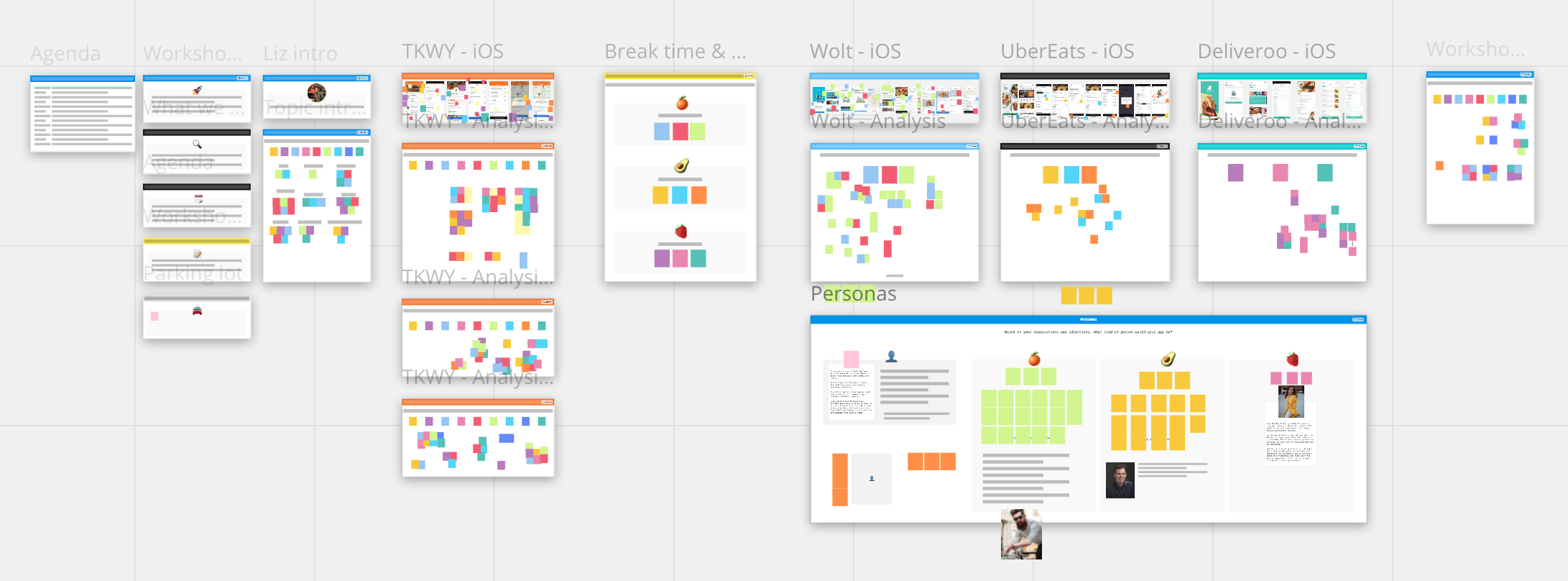
Workshop background
The participants consisted of 5 UI designers, 2 UX researchers, our design lead, and the design operations manager.
As I introduced the topic during the workshop, I asked the participants to jot down ideas and thoughts in the form of “How might we…” questions.
These ideas give an insight into the concerns we have as a team surrounding the topic.
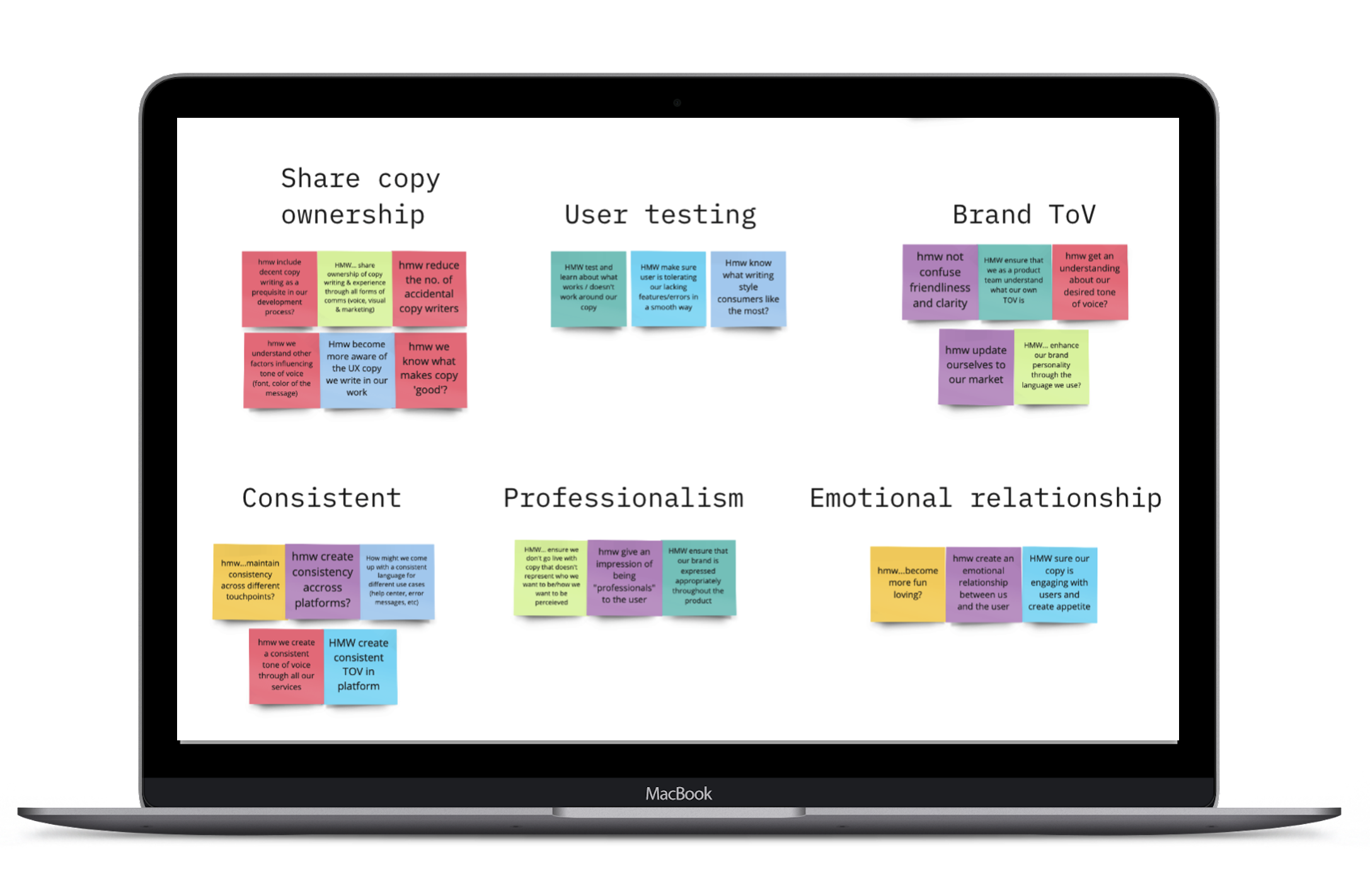
How might we...
...share ownership of copywriting and the experience throughout all forms of communication?
- Reduce the number of accidental copywriters*?
- Understand other factors influencing tone of voice such as font styling and colors?
...understand our brand tone & voice?
- Enhance our brand personality through the language we use?
- Ensure that we as a product team understand what our own TOV is
...maintain consistency across different touchpoints?
- Create a consistent tone of voice through all our services
- Come up with a consistent language for different use cases (help center, error messages, etc.)?
*Accidental copywriters are colleagues who write, decide, and publish copy when that is not their profession/job role
Analyzing our platform
As visual people, we often focus on the design of our app. If it looks good, it must function well, right? This was an opportunity to scrutinize our platform from a copy perspective—ignore the design and focus on just the words. How are we speaking to our consumers?
Analyzing the Takeaway app
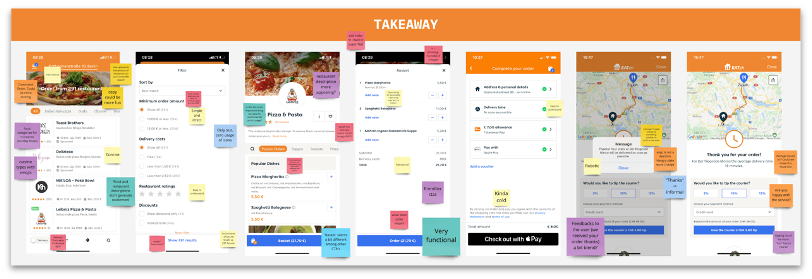
The participants were asked to spend 5 minutes writing down their thoughts, ideas, and observations about the copy in the Takeaway app.
Their major observations were:
- While the copy is direct and functional, it is cold and lacks joy. It doesn’t generate an appetite. One participant described it as “filing taxes”
- The copy is inconsistent throughout the user journey
- The copy can be more fun and friendly, with increased personalization
The participants were asked: Based on your observations, what are the 3 adjectives you'd use to describe the personality of Takeaway?
They answered: technical, generic, and functional
Q: What are 3 adjectives you'd use to describe how you think Takeaway should be?
A: Fun, supportive, and welcoming
The competition
I asked the group to analyze Deliveroo, Wolt, and UberEats.
Participants were then divided into teams of three to analyze the apps in the same format as the Takeaway analysis: note down observations and describe each app using 3 adjectives.
Team Wolt

Key observations:
- “Feels like a friend.” Wolt uses caring, personal language and is not shy of using emojis
- Wolt practices a celebration culture and creates empathy between the consumer and the drivers/restaurants
- Wolt injects their brand identity into their copy, such as “Wolting” and “Wolt specials”
Q: Based on your observations, what are the 3 adjectives you'd use to describe the personality of Wolt?
A: Personal, friendly, and attentive
Team UberEats

Key observations:
- “Tone of a peer.” UberEats tries to be personal
- Their words are direct but there’s a sense of urgency. “Double upsell? Meh.”
- While UberEats is clear, consistent, and easy to read, they are also too wordy
Q: Based on your observations, what are the 3 adjectives you'd use to describe the personality of UberEats?
A: Direct, wordy, and consistent
Team Deliveroo

Key observations:
- “It is a conversation between me and you.” Deliveroo has a consistent, personalized way of approaching pronouns between the consumer (you) and the product (we)
- The copy is clear, functional, and supported by visuals and informative adjectives
- Deliveroo remains positive and playful, even if the message is supposed to be negative
Q: Based on your observations, what are the 3 adjectives you'd use to describe the personality of Deliveroo?
A: Approachable, consistent, and promotional
Creating personas
Now for the fun part. Since this was a writing workshop, I wanted participants to get creative: I asked them to write personas based on their 3 adjectives.
“Based on your observations and adjectives, what kind of person would your app be?”
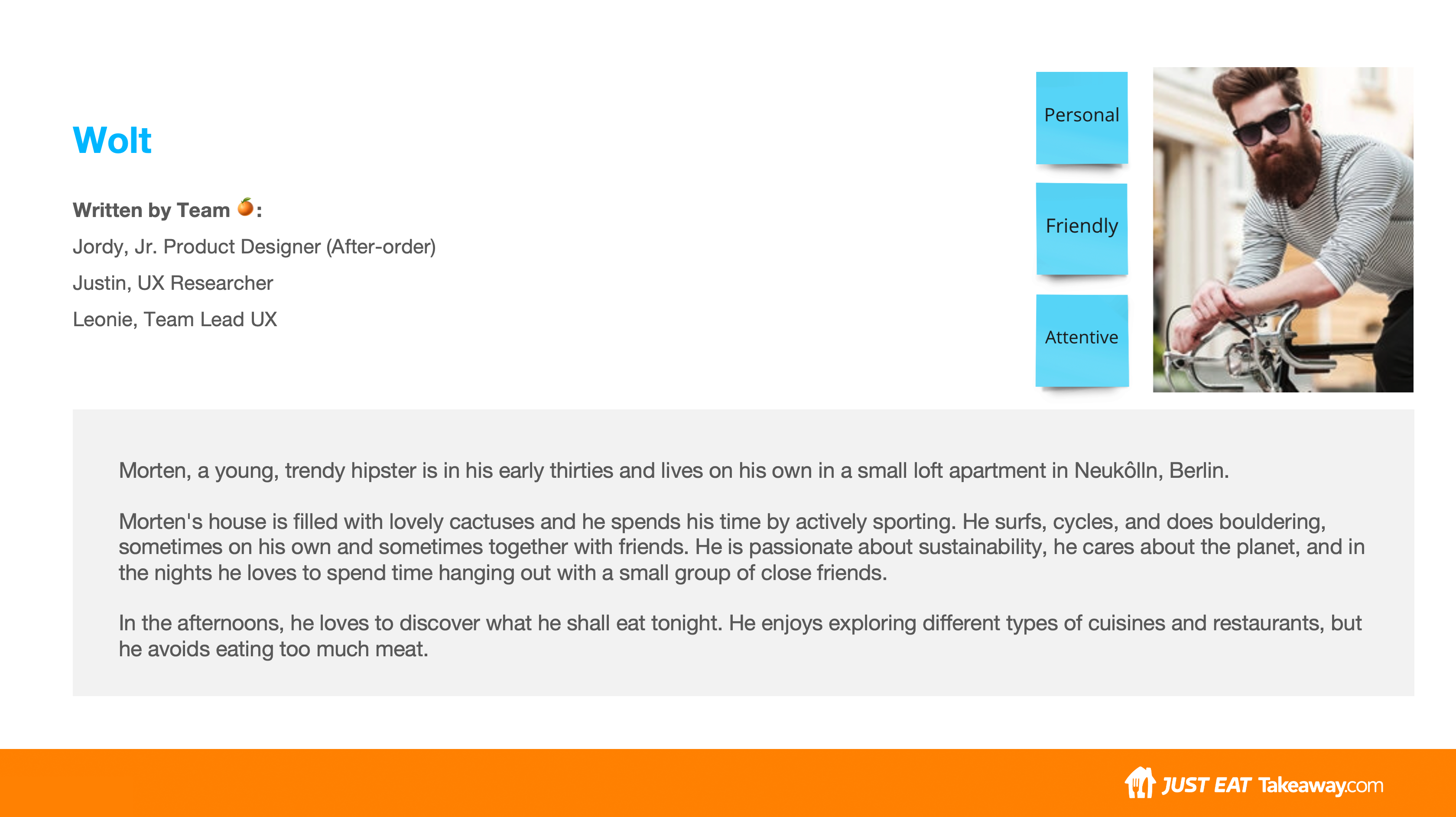
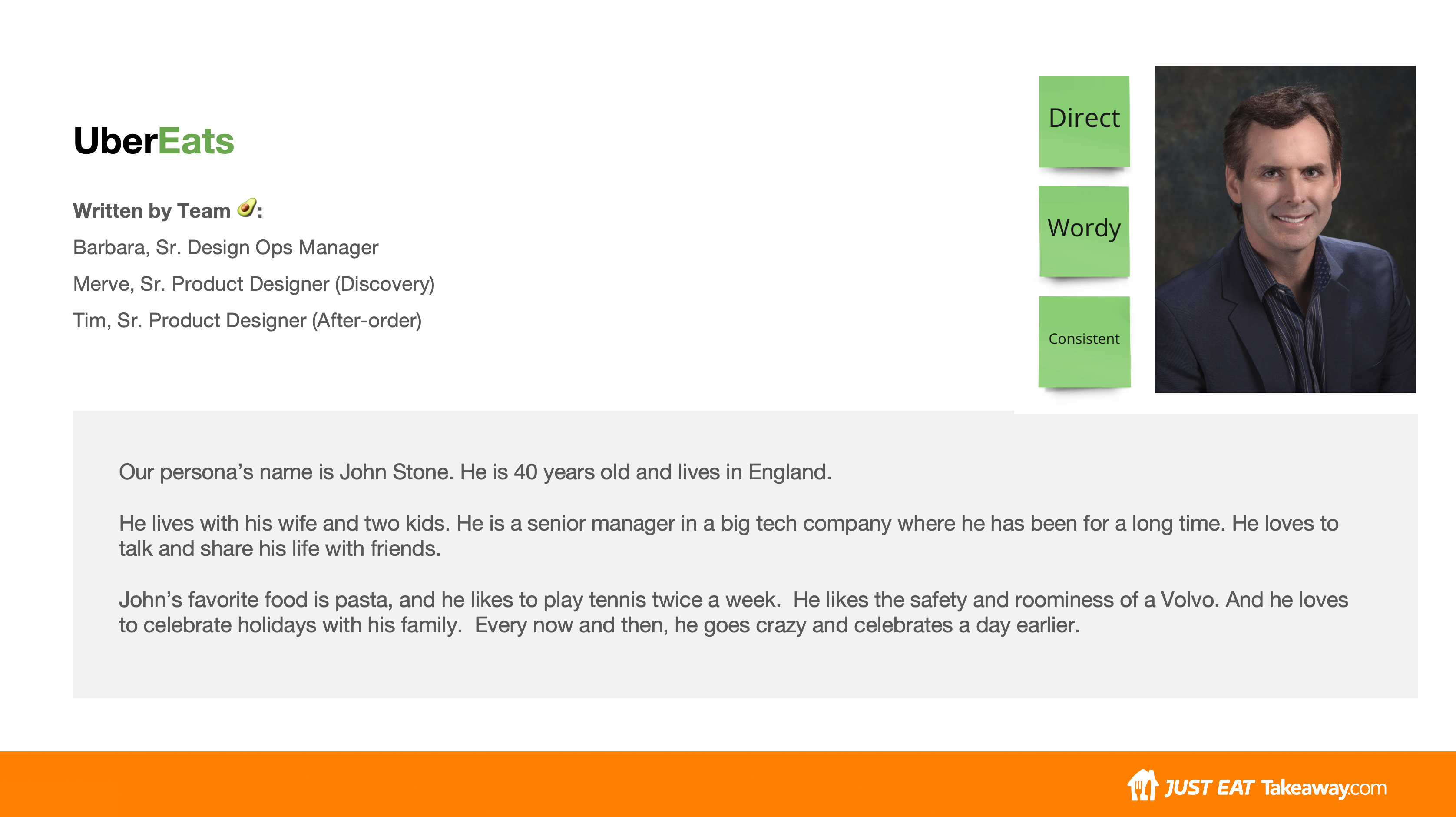
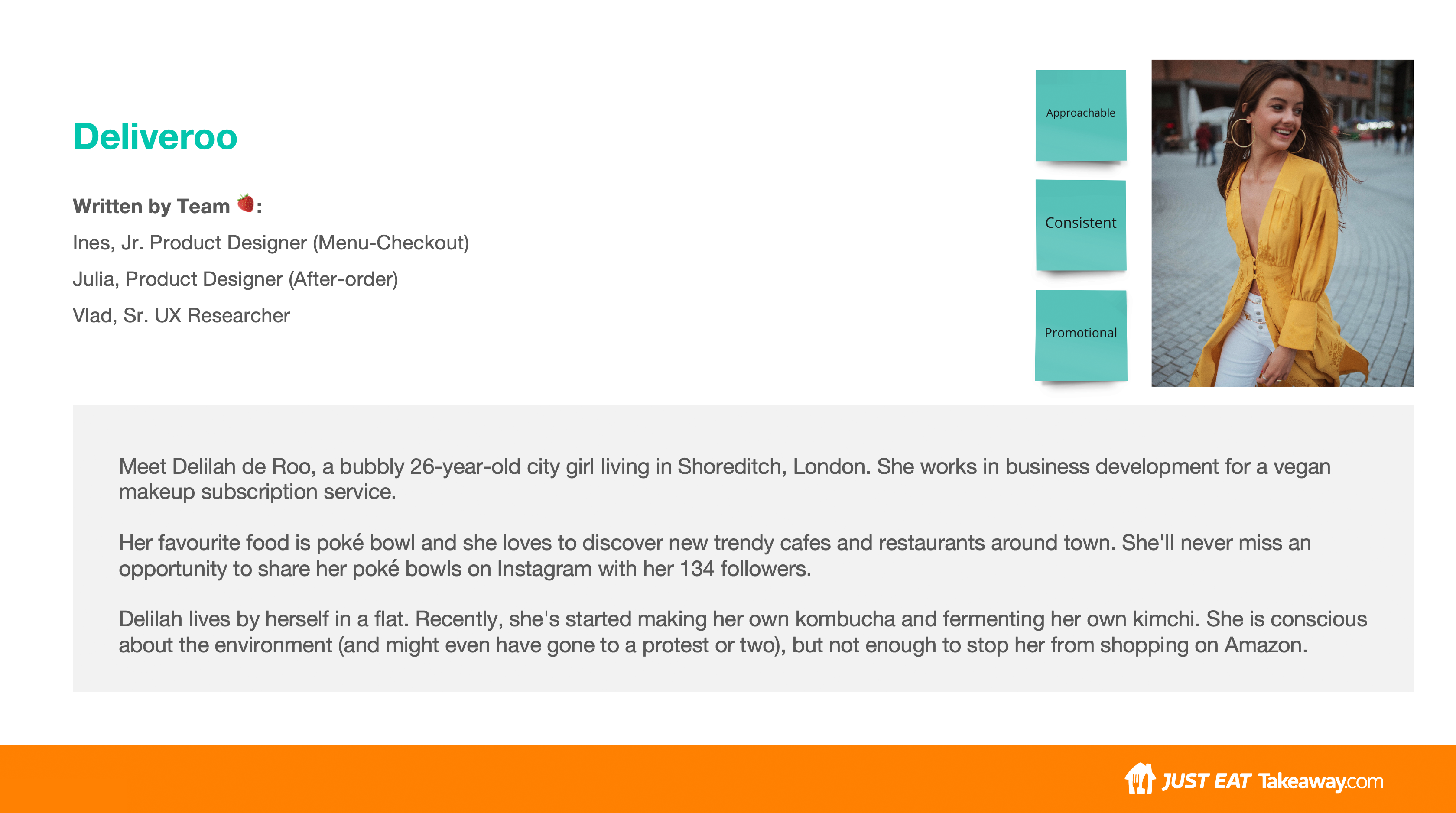
Tap the arrows on the left and right of the image to navigate.
The participants had a lot of fun creating their personas and even added images to represent them. While the exercise was delightful, it also showed how every platform used a different voice, even though they may look similar.
The most striking observation was UberEats. One participant said that he assumed that UberEat was targeted towards university students based on the trendy illustrations. But the copy says something else.
Good microcopy is a team effort
By extending my work to my colleagues, I was able to show them how much copy impacts the tone and voice of the brand.
I created a presentation deck from the results of this workshop to advocate for:
- More user testing and research. By conducting more user tests, interviews, and copy-focused research, we can understand how our consumers perceive the brand.
- Earlier collaboration with UX writers. If designers, researchers, and writers collaborate earlier in the process, we can look for inconsistencies, create guidelines, and analyze the copy and content together. We can also add copy improvements to the roadmap and explore UX writing even further within the consumer verticals.
- Designers to work with copy in mind. When designers are empowered with UX writing principles, they can create in more innovative ways: using storytelling instead of only visuals, creating screen mockups with different writing styles, and checking copy before every new feature is released.
Since the workshop, designers are excited by opportunities to include conversational and human-centered copy. UX writing is no longer seen as the final step but during the inception of a new vision.
Conclusion
To keep up within the market, being functional is simply not enough.
Consumers are already experiencing warm service, strong brand identities, and playful copy from competitor apps. This is why microcopy is so important, and why UX writing as a profession has skyrocketed.
Writing may seem simple, but it's part of content design. We can already decide where copy can live in the user flow, wireframes, and design visuals.
A single word can make a big difference in how consumers perceive a product.
All research and insights are copyright of Just Eat Takeaway




